A 1924 penny is nearly a hundred years old, which contributes to its increased value. Even in average condition, a 1924 penny is worth about 75 cents, while those in exceptional condition can reach up to $35,000!
Let’s dive into the different variants of the 1924 penny and their corresponding values, as well as some errors that can increase its worth.
1924 Penny Value Chart
| Mint Mark | Good | MS-61 | MS-62 | MS-63 | MS-65 | MS-66 | MS-67 | Proof Grade |
|---|---|---|---|---|---|---|---|---|
| 1924 No Mint Mark Penny (Philadelphia) | $0.25 | $27 | $32 | $45 | $80 | $180 | – | – |
| 1924 “D” Mint Mark Penny | $30 | $320 | $350 | $540 | $1,300 | $3,000 | – | – |
| 1924 “S” Mint Mark Penny | $1.50 | $165 | $200 | $340 | $1,600 | – | – | – |
History
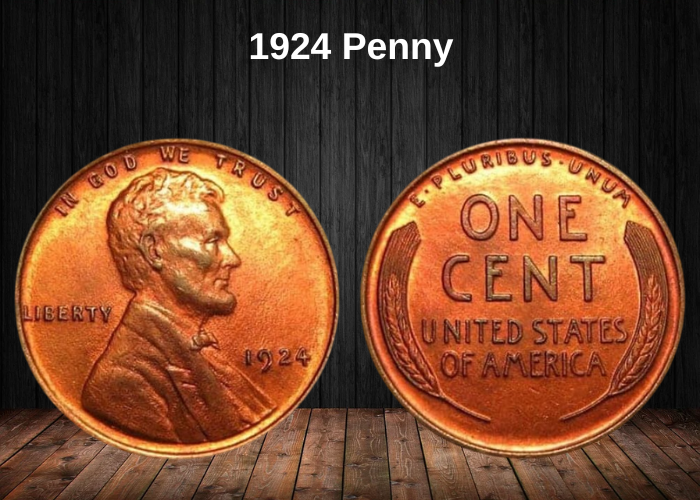
The 1924 Penny is a notable coin in U.S. history, part of the Lincoln Wheat Cent series. Produced by the U.S. Mint, it features the iconic portrait of President Abraham Lincoln on the obverse, designed by Victor David Brenner. The reverse displays two wheat stalks, symbolizing the nation’s agricultural strength. The 1924 Penny was struck in a time of economic transition, just a few years before the Great Depression. It is considered a common coin, though some varieties, such as those with different mintmarks (Philadelphia, Denver, and San Francisco), can hold greater value for collectors. The 1924 Lincoln Wheat Cent remains a symbol of early 20th-century American coinage.
1924 Penny Grading
To determine the accurate value of a 1924 penny, it’s important to grade it properly. A professional grading service typically charges a basic fee ranging from $22 to $80 for grading a single coin, excluding shipping and insurance fees.
However, you can start by grading the coin yourself at home before deciding whether to send it to a professional service like PCGS or NGC. The process is quite simple, and with the right tools and knowledge, you can assess your coin like a professional.
Here’s a basic coin grading scale to help you evaluate your 1924 penny:
| Grade | Description |
|---|---|
| 1 (Basal State-1) | Extremely worn, barely identifiable |
| 2 (Fair) | Heavily worn, design nearly illegible |
| 3 (Very Fair) | Significant wear but more details visible than fair grade |
| 4, 5, 6 (Good) | Wear is visible but main features can still be identified |
| 7, 8, 10 (Very Good) | More details visible, some wear but major design elements remain |
| 12, 15 (Fine) | Moderate wear, design visible but with noticeable scratches |
| 20, 30 (Very Fine) | Light wear, much of the original detail still intact |
| 40 (Extremely Fine) | Slight wear on high points, nearly full detail retained |
| 50 (About Uncirculated) | Light wear, only minor signs of circulation |
| 60 (Mint State) | No visible wear, perfect details |
| 65 (Mint State) | Nearly perfect, only small imperfections visible |
| 70 (Mint State) | Perfect coin, no flaws visible |
For a more accurate 1924 penny value, using this grading scale is the first step. If you believe your coin might be worth several hundred dollars or more, it’s wise to have it evaluated by a professional service like PCGS or NGC to get an official grade.
Make sure to consult detailed grading guides to familiarize yourself with the different grades and the factors that affect a coin’s value.
1924 No Mint Mark Penny Value (Philadelphia)
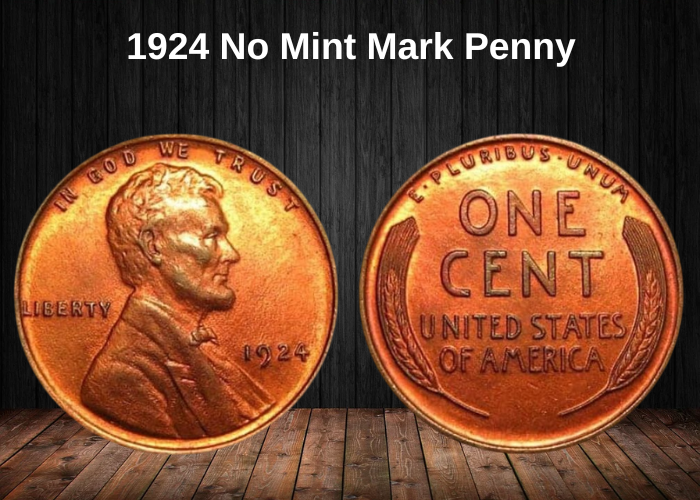
Among the three versions of the 1924 penny, the No Mint Mark variety is the most common, with around 75,178,000 coins minted at the Philadelphia Mint. As a result, it doesn’t attract much interest from collectors, unless it’s an MS-67 red variant.
The 1924 No Mint Mark penny is found in three color variants:
- Brown (BN)
- Red-Brown (RB)
- Red (RD)
The brown (BN) versions are the most prevalent, making them the least valuable. Here’s an overview of their value:
- Good: $0.25
- Fine: $0.75
- Extremely Fine: $6.50
- MS-50 BN: $12
- MS-55 BN: $17.50
- MS-60 BN: $22
- MS-61 BN: $27
- MS-62 BN: $32
- MS-63 BN: $45
- MS-64 BN: $65
- MS-65 BN: $80
- MS-66 BN: $180
The red-brown (RB) variants are more valuable, as they retained more of their original luster due to being less circulated. Here’s how their value breaks down:
- MS-61 RB: $30
- MS-62 RB: $40
- MS-63 RB: $80
- MS-64 RB: $105
- MS-65 RB: $225
- MS-66 RB: $675
Since red-brown coins weren’t circulated regularly, they typically appear in better condition and are more valuable than the brown variants. However, brown and red-brown versions are not available in proof-grade quality.
The red (RD) variants hold the highest value, as they retain 95% of their original mint color, giving them a vibrant copper-red appearance. These are relatively rare, and their values are:
- MS-62 RD: $58
- MS-63 RD: $100
- MS-64 RD: $150
- MS-65 RD: $535
- MS-66 RD: $1,600
- MS-67 RD: $13,500
The highest-value 1924 RD penny is an MS-67 RD that sold for around $38,238 in 2006, setting the record for the finest quality.
All 1924 No Mint Mark pennies are composed of 95% copper and 5% tin and zinc, weighing 3.11 grams with a face value of one cent.
If you own a 1924 penny, it’s highly recommended to have it professionally graded to determine its value, especially if you think it might be worth a considerable amount. Selling it to an expert or collector familiar with its value is key to getting the best price.
The 1924 penny showcases the same design as the 1923 penny, created by Victor David Brenner in 1909. The obverse features a portrait of Abraham Lincoln, with the word “LIBERTY” on the left and the year of minting on the right. The reverse has “ONE CENT” at the top, “UNITED STATES OF AMERICA” in the center, and “E Pluribus Unum” at the top, with wheat stalks on either side. This design was replaced in 1958 with the Lincoln Memorial design, which is why this penny is often called the Wheat penny.
This coin has no significant historical events tied to it, but its iconic design and varying conditions make it valuable to collectors.
1924 “D” Mint Mark Penny Value
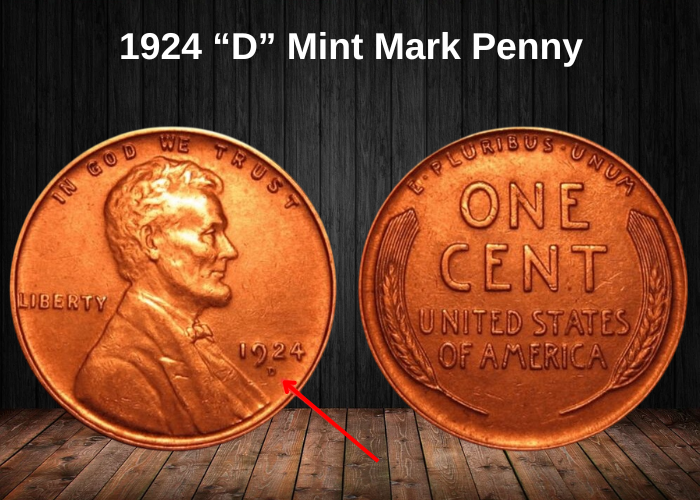
The second variant of the 1924 penny is the D Mint Mark penny, struck at the Denver Mint. This variant is less common than the No Mint Mark variety, with only 2,520,000 coins minted. This lower mintage makes the D Mint Mark penny relatively rare and thus more valuable.
In terms of appearance and composition, the D Mint Mark penny is the same as the No Mint Mark penny, except for the small “D” placed just below the year of minting on the obverse side.
As with the No Mint Mark penny, the red variant of the D Mint Mark penny is the rarest and most valuable. Here’s a breakdown of the average value of the D Mint Mark penny based on its grade and color:
Brown (BN) Variant:
- Good (G): $30
- Very Good (VG): $38
- Fine (F): $45
- Very Fine (VF): $65
- Extremely Fine (XF): $115
- MS-50 BN: $165
- MS-53 BN: $180
- MS-55 BN: $230
- MS-58 BN: $260
- MS-60 BN: $290
- MS-61 BN: $320
- MS-62 BN: $350
- MS-63 BN: $540
- MS-64 BN: $725
- MS-65 BN: $1300
- MS-66 BN: $3000
Several brown D Mint Mark 1924 pennies have been sold at auction, and the prices can vary based on the specific grade. The values mentioned are averages, but actual auction prices can be higher or lower.
Red-Brown (RB) Variant:
- MS-61 RB: $340
- MS-62 RB: $420
- MS-63 RB: $675
- MS-64 RB: $1175
- MS-65 RB: $3400
- MS-66 RB: $6250
Although the red-brown D Mint Mark 1924 pennies are rare and valuable, they have not yet reached values higher than $10,000 in most cases.
Red (RD) Variant:
- MS-62 RD: $440
- MS-63 RD: $1100
- MS-64 RD: $2900
- MS-65 RD: $13,000
- MS-66 RD: $70,000
The red variants fetch even higher prices, with MS-66 RD reaching as high as $70,000. However, these red variants are incredibly rare. For instance, there are only 2 reported MS-66 RD units of the 1924 D Mint Mark penny and only 18 available MS-65 RD units.
The most available red variant is the MS-64 RD, with about 27 units in circulation.
The D Mint Mark penny is highly sought after, especially in higher grades, with the red variants being the most valuable due to their rarity and vibrant copper-red appearance.
1924 “S” Mint Mark Penny Value
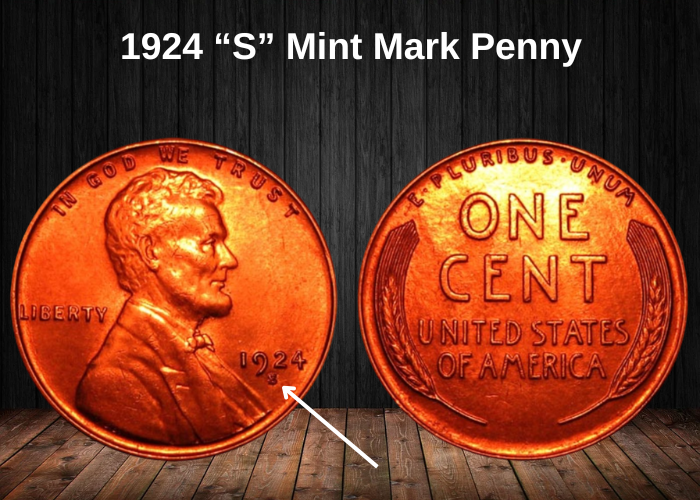
Finally, we have the 1924 penny variant from the San Francisco Mint. This version is similar in design and composition to the No Mint Mark and D Mint Mark pennies, with the key difference being a small “S” placed beneath the year on the obverse side of the coin.
A total of 11,696,000 units of this penny were minted at the San Francisco Mint, which is fewer than the Philadelphia Mint’s production but more than the Denver Mint’s. As a result, the S Mint Mark 1924 penny is rarer than the No Mint Mark penny but less rare than the D Mint Mark penny.
Valuation of the 1924 S Mint Mark Penny:
Brown (BN) Variant:
- Good (G): $1.50
- Very Good (VG): $2
- Fine (F): $3.75
- Very Fine (VF): $24
- Extremely Fine (XF): $35
- MS-50 BN: $85
- MS-53 BN: $90
- MS-55 BN: $95
- MS-58 BN: $105
- MS-60 BN: $125
- MS-61 BN: $165
- MS-62 BN: $200
- MS-63 BN: $340
- MS-64 BN: $650
- MS-65 BN: $1600
The brown S Mint Mark pennies are relatively accessible in lower grades, but in higher grades, like MS-65, they can fetch up to $1600.
Red-Brown (RB) Variant:
- MS-61 RB: $200
- MS-62 RB: $260
- MS-63 RB: $500
- MS-64 RB: $1125
- MS-65 RB: $3950
The red-brown S Mint Mark pennies are rarer, and their value increases significantly in higher grades.
Red (RD) Variant:
- The red S Mint Mark pennies are exceptionally rare. There is only one MS-65 RD 1924 penny known, and its estimated value is $29,000.
- The S Mint Mark 1924 penny is rare but less so than the D Mint Mark penny.
- Brown pennies are relatively common in lower grades, but those in higher grades, like MS-65, can be worth up to $1600.
- Red-brown variants can reach values of up to $3950 in high grades.
- The red variant of the S Mint Mark penny is extremely rare, and one of these pennies has an estimated worth of $29,000.
If you own a red S Mint Mark penny, especially in MS-65 grade, you may have a highly valuable coin in your hands!
Rare 1924 Penny Error List
1924 Penny Double Die Error
A double die error happens when a coin’s design is stamped twice, but slightly misaligned, leading to a doubled image. This error occurs during the hubbing process when the die, which is responsible for pressing the design onto the coin, unintentionally receives a partial or full double impression.
This results in a distinctive appearance on the coin, with some of the design elements appearing as doubled or shifted, giving the coin a unique and rare look.
For 1924 pennies, this type of error is particularly valuable and highly sought after by collectors. Coins with this double die error can often command premium prices, especially if the doubling is clearly visible and enhances the aesthetic appeal of the coin.
If you have a 1924 penny that you suspect might be a double die error, it’s worth having it examined by a professional or coin expert, as such coins can be significantly more valuable than regular ones.
1924 Penny Repunched Error
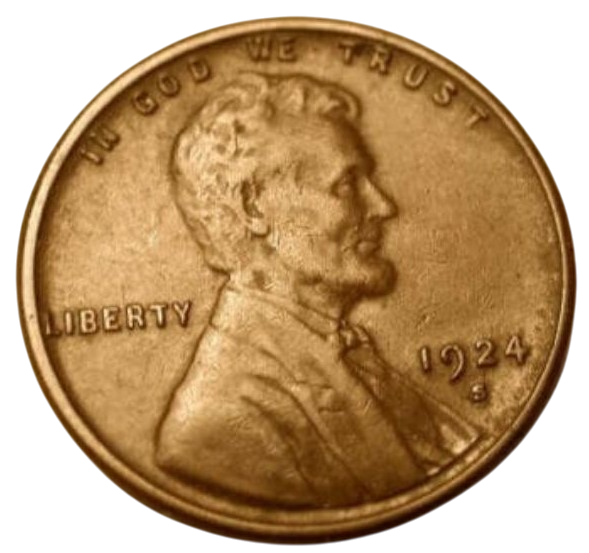
A repunched mintmark (RPM) error occurs when the mintmark on a coin is struck more than once, resulting in overlapping images on the coin’s surface. This happens when the die is misaligned and strikes the coin again, leaving behind a visible mark of the original mintmark alongside the new one.
For a 1924 penny, an RPM error is quite rare, making it a valuable find for collectors. The value of such a coin can vary depending on factors like the grade of the coin, the clarity of the repunched mintmark, and the overall condition. Typically, a 1924 RPM penny can be valued at $75 or more, with the price increasing for higher-grade examples and clearer repunching.
If you come across a 1924 penny with this error, it’s worth having it professionally graded, as its rarity and error could make it significantly more valuable than a standard 1924 penny.
1924 Penny Off-Center Error
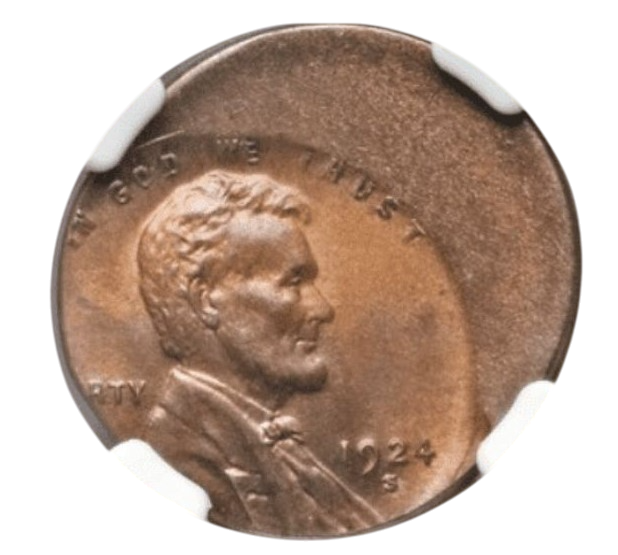
An off-center error occurs when the coin is not properly aligned on the die during the minting process. As a result, part of the coin’s design is missing, and the design appears shifted to one side of the coin.
The value of a 1924 penny with an off-center error depends on the degree of misalignment. The more off-center the design is, the more valuable the coin can be. For example, a 1924 penny with a 15% off-center error would generally be less valuable than a 1924 penny with a 20% or 30% off-center error, which would be considered rarer and more attractive to collectors.
Coins with large off-center errors are particularly appealing to collectors because of their uniqueness, and they can fetch a premium price at auction depending on the degree of the error and overall coin condition. Typically, the value increases with the severity of the off-center strike.
1924 Penny Thinning Error
A thinning error happens when the metal used for the coin doesn’t flow evenly during the minting process, resulting in some parts of the coin being thinner than others. This uneven thickness creates thin spots or areas where the coin’s design is less defined or might appear more worn out.
Thinning errors are a rarity in coinage, and as a result, they tend to be highly sought after by collectors. The value of a coin with a thinning error often increases, especially if the error is noticeable and affects key areas of the coin’s design. The premium price collectors are willing to pay depends on several factors:
- Extent of the error – the more pronounced and noticeable the thinning, the more valuable the coin is.
- Coin condition – a coin in higher grade with a thinning error will be worth more than a heavily worn coin.
- Rarity of the specific variant – a 1924 penny, for instance, could be more valuable if it’s a thinning error from a specific mint mark or grade.
If you have a 1924 penny with a thinning error, it’s advisable to have it evaluated by a professional, as such coins can be quite rare and potentially very valuable.
1924 Penny Cracked Die Error
A cracked die error occurs when the die, the tool used to stamp the design onto the coin, develops a crack during the minting process. This crack then leaves a line or split in the design, which is visible on the coin. These errors are particularly rare because the cracks in the die usually occur after a significant amount of use, and coins that are minted with a cracked die often have visible defects in the design, especially around the cracked areas.
The presence of a cracked die error makes the coin much more unique, which is why collectors are willing to pay a premium for such coins. Depending on the severity of the crack, the rarity of the coin, and the grade of the coin, a cracked die error can increase the value significantly. For example, a 1924 penny with this error might sell for a few hundred dollars, or even more if it’s in exceptional condition.
Collectors often highly value such rare errors because they are signs of the coin’s history and production process, making them a special addition to any collection. If you find a cracked die 1924 penny, it would be worthwhile to have it evaluated by a professional to determine its exact value based on its condition and rarity.
Where to sell your penny?
Now that you know the value of your penny, you might be wondering where to sell it. Don’t worry: here’s a guide to some of the best online platforms where you can easily sell your coins, along with their advantages and disadvantages.
Discover the best platforms for selling coins online (pros and cons).
1924 Penny Value FAQs
Q1: What is the 1924 Wheat Penny?
The 1924 Wheat Penny is a one-cent coin from the United States, part of the Wheat Penny series minted from 1909 to 1958. It features the iconic portrait of Abraham Lincoln on the obverse and two ears of wheat on the reverse. The coin was minted during the early 1920s, a period marked by post-World War I prosperity and the economic changes of the Roaring Twenties.
Q2: What are the specifications of the 1924 Wheat Penny?
- Type: Wheat Penny
- Year: 1924
- Composition: 95% copper, 5% tin and zinc
- Total Weight: 3.11 grams
- Diameter: 19mm
- Minting Locations: Philadelphia, Denver, and San Francisco
Q3: How many 1924 Wheat Pennies were minted?
The mintage of the 1924 Wheat Penny was as follows:
- 1924 (Philadelphia): 159,114,000
- 1924 D (Denver): 10,490,000
- 1924 S (San Francisco): 6,400,000
While the Philadelphia mint produced the vast majority of these coins, the San Francisco and Denver varieties are generally considered to be rarer, with the 1924 S being particularly sought after by collectors due to its relatively lower mintage.
Q4: What is the value of a 1924 Wheat Penny?
The value of the 1924 Wheat Penny can vary depending on its condition and mint mark. Below are estimated values for the coin based on its condition:
- 1924 (Philadelphia):
- Good: $0.50
- Very Fine: $1.50
- Extremely Fine: $3.00
- Uncirculated: $8.00 – $20.00
- 1924 D (Denver):
- Good: $1.00
- Very Fine: $3.00
- Extremely Fine: $7.00
- Uncirculated: $20.00 – $50.00
- 1924 S (San Francisco):
- Good: $1.50
- Very Fine: $5.00
- Extremely Fine: $12.00
- Uncirculated: $30.00 – $75.00
Q5: Why is the 1924 S Wheat Penny more valuable than the Philadelphia version?
The 1924 S Wheat Penny is more valuable than the Philadelphia version due to its lower mintage of just 6,400,000 coins, making it scarcer in high grades. Several factors contribute to its higher value:
- Lower Mintage: With significantly fewer coins minted at the San Francisco Mint, the 1924 S penny is harder to find in circulation today, which drives its collector demand.
- Collector Demand: Rare coins from the San Francisco Mint, particularly from years like 1924, are often highly sought after by numismatists and collectors who specialize in mint mark varieties.
- Regional Circulation: The 1924 S penny may have circulated mainly in the western United States, contributing to its rarity in other parts of the country.
Q6: What is the design of the 1924 Wheat Penny?
The design of the 1924 Wheat Penny follows the standard Wheat Penny design, which includes:
- Obverse: The portrait of Abraham Lincoln, designed by Victor David Brenner, with the inscription “LIBERTY” and the year “1924” beneath his bust. The motto “IN GOD WE TRUST” is also visible on this side.
- Reverse: The reverse features two stalks of wheat with the words “UNITED STATES OF AMERICA” and “E PLURIBUS UNUM” along the top and bottom. The “ONE CENT” denomination is inscribed in the center.
Q7: Are there any known errors or varieties with the 1924 Wheat Penny?
The 1924 Wheat Penny is not particularly famous for minting errors, but collectors may still find some subtle variations. The primary factors influencing its value are:
- Mint Mark Variations: The three mint locations—Philadelphia (no mint mark), Denver (D), and San Francisco (S)—result in different collector values. The 1924 S and 1924 D coins are more highly sought after due to their lower mintage figures.
- Die Variations: While not as significant as other rare coins, there can be slight die variations such as different fonts or spacing on the letters, but these are not as common or impactful as other varieties in the Wheat Penny series.
Q8: How did the 1924 Wheat Penny fit into the broader context of U.S. coinage during the early 20th century?
The 1924 Wheat Penny reflects a transitional moment in U.S. coinage:
- Economic Context: The 1920s were marked by economic prosperity, but the decade ended with the Great Depression. The 1924 penny represents the final years of the U.S. economy before the crash of 1929, which would lead to significant changes in both the nation and its coinage.
- Design Legacy: The Lincoln Wheat Penny was part of a series that became an enduring symbol of the nation’s history. The 1924 penny, like other coins in the series, would remain in circulation until the introduction of the Lincoln Memorial design in 1959.
- Technological and Industrial Change: The 1920s also saw major advances in industry, manufacturing, and transportation. The penny, though small, represents the time when American society was undergoing profound changes, transitioning from an agrarian economy to an industrialized and urbanized society.
Q9: How does the 1924 Wheat Penny compare to other coins of the same era, like the 1924 Silver Dollar or the 1924 Buffalo Nickel?
Compared to other coins from the same year, such as the 1924 Silver Dollar or the 1924 Buffalo Nickel, the 1924 Wheat Penny holds several distinctions:
- Value: The 1924 Wheat Penny, despite its historic significance, is generally much less valuable than the 1924 Silver Dollar, which was minted in limited numbers and has a higher precious metal content (90% silver). However, the penny is more widely available and accessible to a broader range of collectors.
- Design Appeal: While the 1924 Buffalo Nickel is admired for its detailed and iconic Native American design, the Wheat Penny is more significant in terms of historical symbolism (representing the nation’s agricultural roots) and its connection to the long-running Lincoln portrait series.
- Collectibility: The 1924 Wheat Penny is a common coin compared to the Buffalo Nickel and Silver Dollar, but its value increases significantly in higher grades and rarer mint marks like S or D. Additionally, the 1924 penny is often sought by collectors specializing in Lincoln Cent series.
Q10: How should I store and preserve my 1924 Wheat Penny to protect its value?
To preserve the value of your 1924 Wheat Penny, especially if it’s in uncirculated or high-grade condition, proper storage is essential:
- Use a Protective Holder: Place the penny in a 2×2 holder, slab, or coin capsule to protect it from physical damage, tarnishing, or exposure to harmful environmental elements like moisture.
- Avoid Touching the Coin: Handle the coin with cotton gloves or avoid direct contact with your fingers, as oils and dirt from your hands can degrade the coin’s surface and affect its value.
- Store in a Safe Place: Keep your coins in a cool, dry place away from direct sunlight, extreme temperatures, or humidity. For higher-value coins, consider using a safe or a bank safety deposit box.



















































